A Review of the CFD Modeling of Hydrogen Production in Catalytic Steam Reforming Reactors
Abstract
1. Introduction
2. Mathematical Models
CFD Modeling Equations
3. Types of Membrane Reactors
3.1. Reformer with a Variable Number of Membranes
3.2. Catalyst Decomposition
3.3. Membrane-Based Reactor
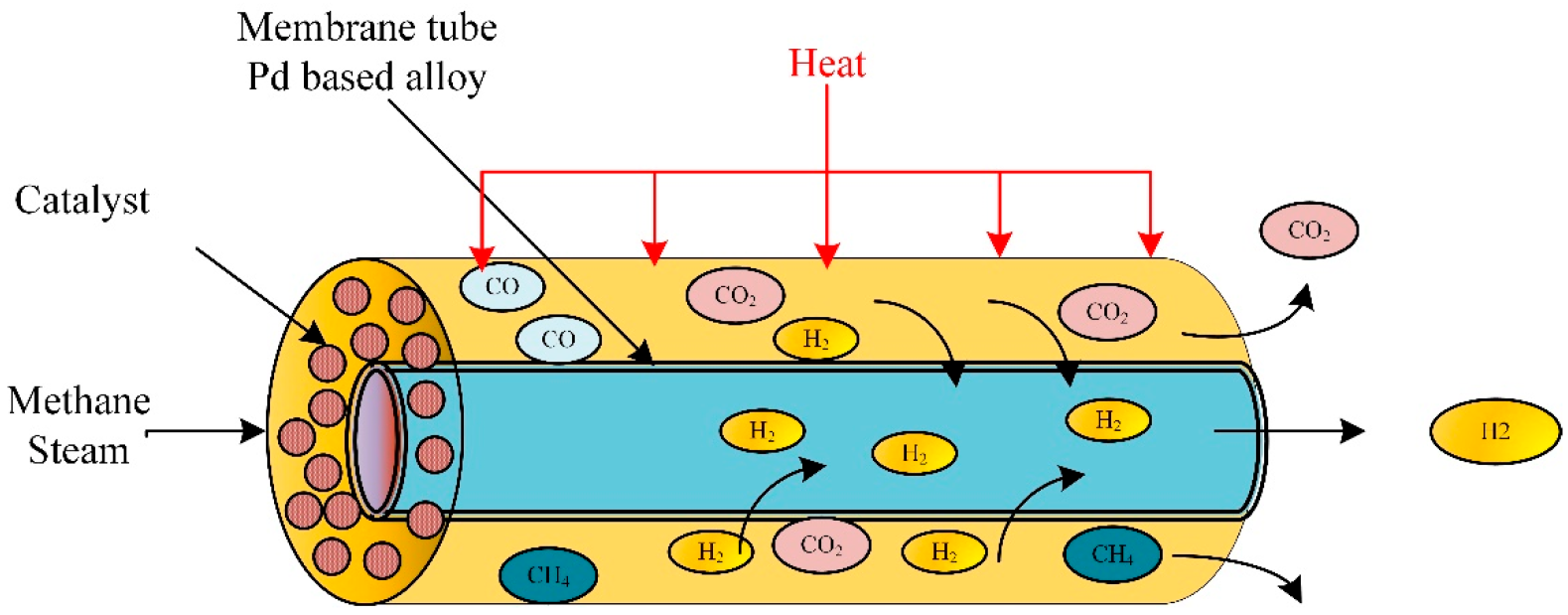
3.4. Membrane-Based Fixed Bed Reactor
3.5. Microchannel Plates Steam Reformer
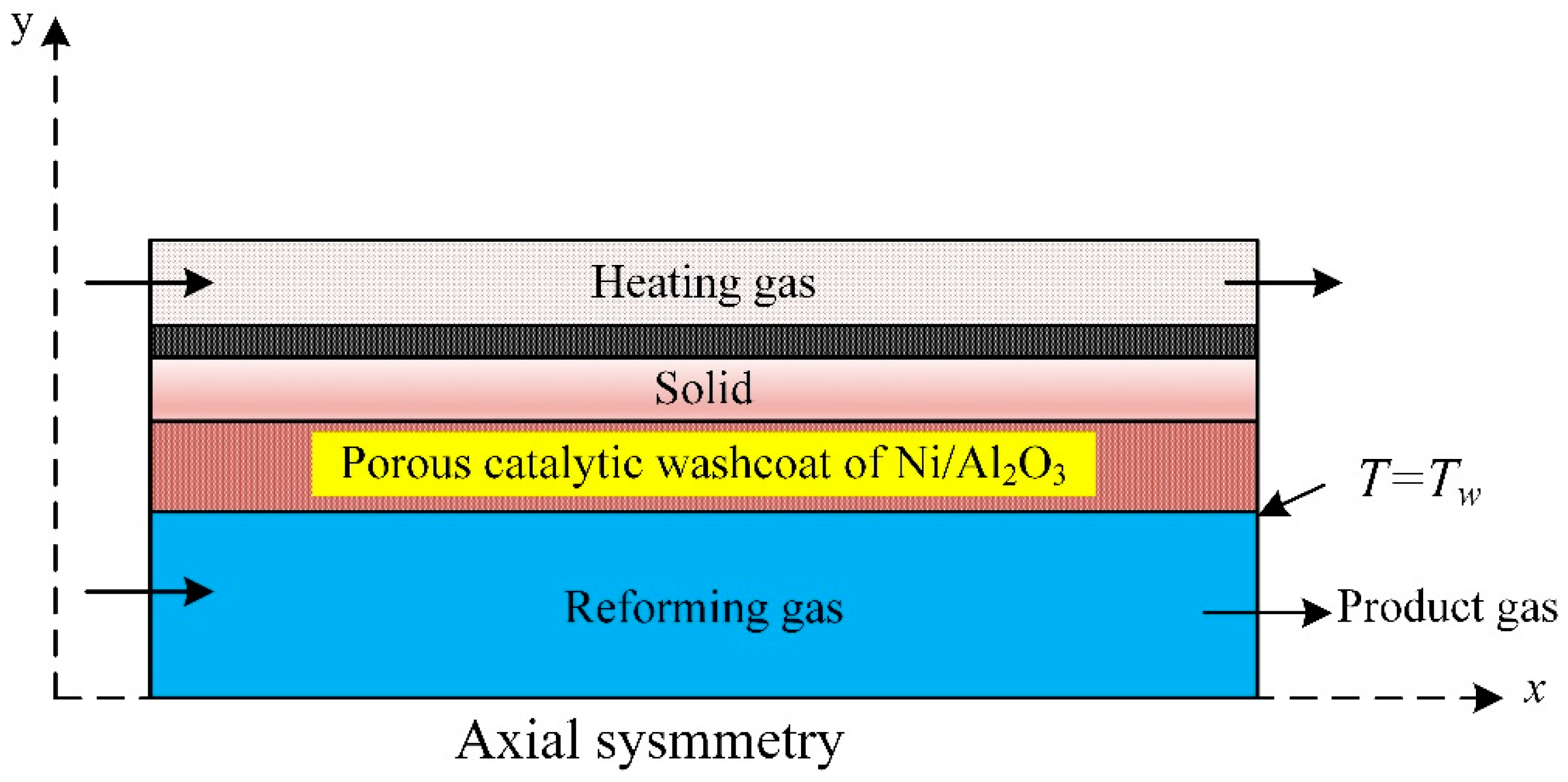
3.6. Packed Bed Tubular Reactor

3.7. Membrane-Assisted Packed Bed Reactor
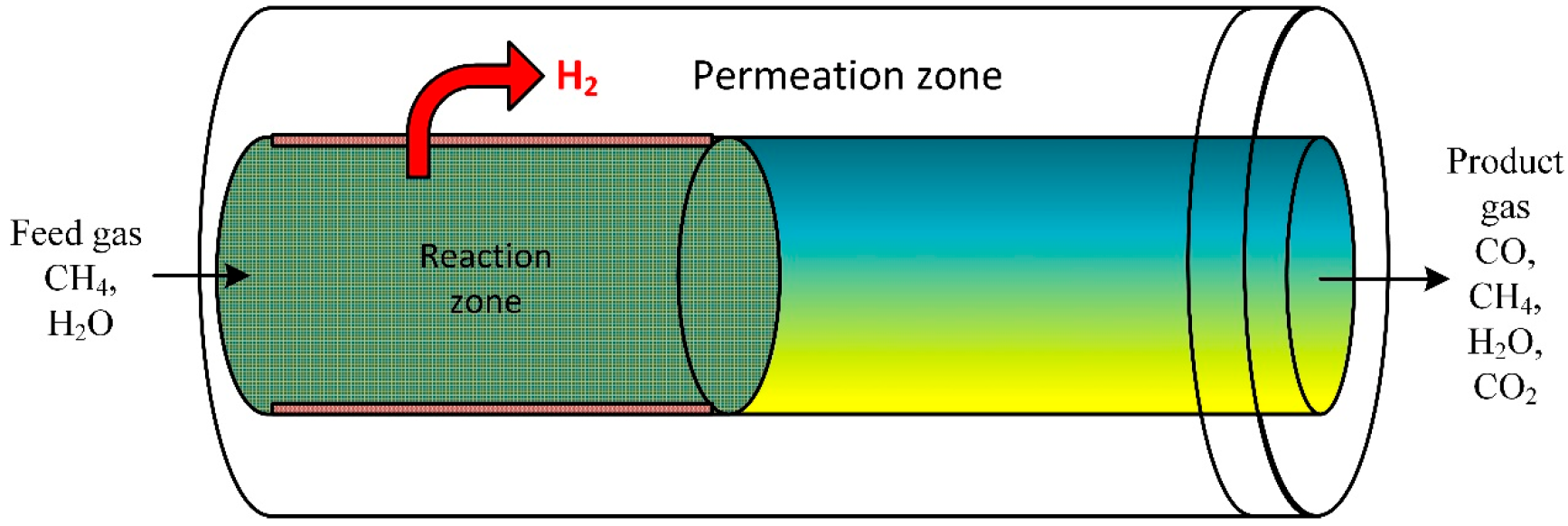
3.8. Double Coupled Reactor
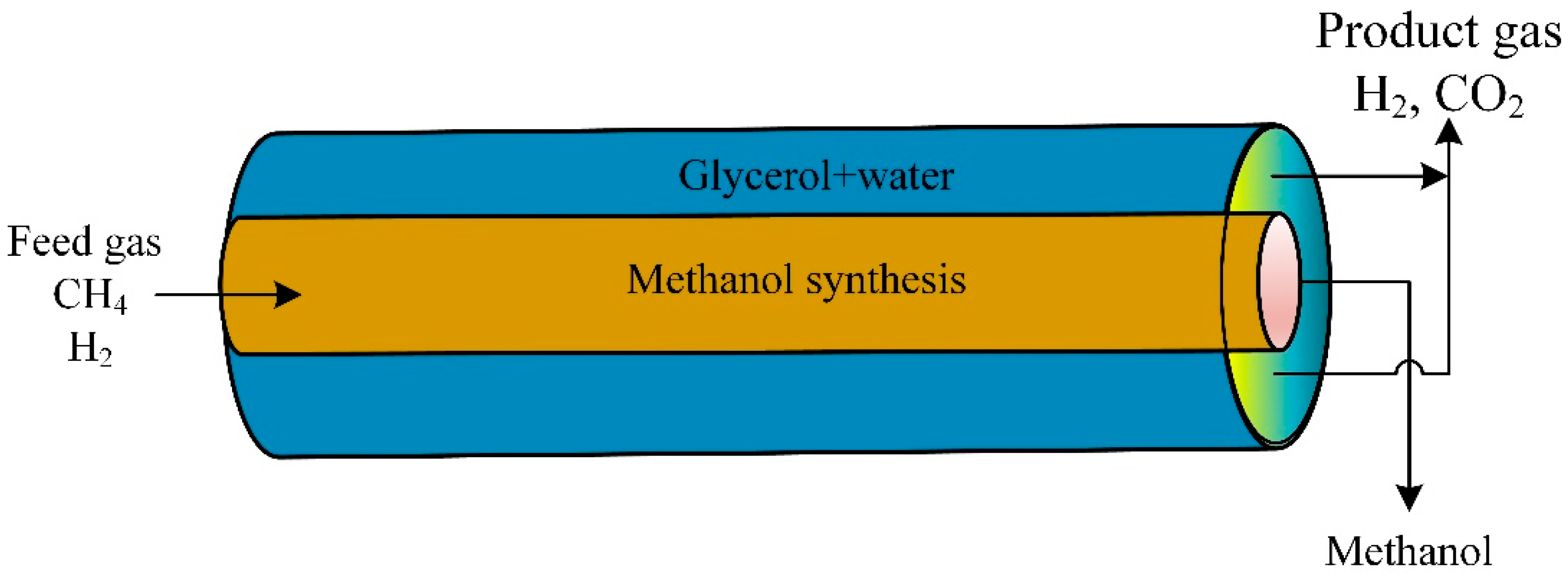
3.9. Catalytic Plate Reactor
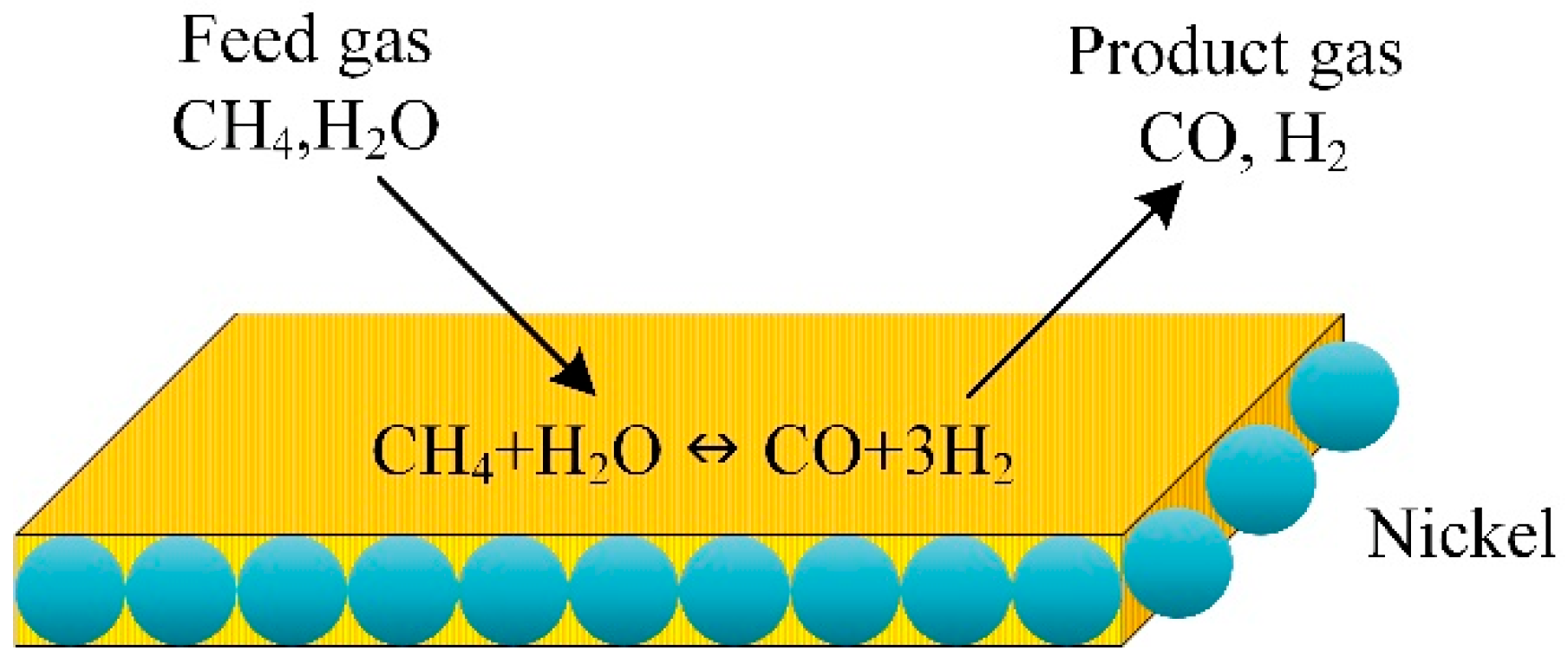
3.10. Traditional versus Membrane Reactor
4. Conclusions
Funding
Institutional Review Board Statement
Informed Consent Statement
Data Availability Statement
Conflicts of Interest
References
- Meloni, E.; Martino, M.; Iervolino, G.; Ruocco, C.; Renda, S.; Festa, G.; Palma, V. The Route from Green H2 Production through Bioethanol Reforming to CO2 Catalytic Conversion: A Review. Energies 2022, 15, 2383. [Google Scholar] [CrossRef]
- Renda, S.; Cortese, M.; Iervolino, G.; Martino, M.; Meloni, E.; Palma, V. Electrically Driven SiC-Based Structured Catalysts for Intensified Reforming Processes. Catal. Today 2022, 383, 31–43. [Google Scholar] [CrossRef]
- Ishaq, H.; Dincer, I.; Crawford, C. A Review on Hydrogen Production and Utilization: Challenges and Opportunities. Int. J. Hydrogen Energy 2022, 47, 26238–26264. [Google Scholar] [CrossRef]
- Yu, M.; Wang, K.; Vredenburg, H. Insights into Low-Carbon Hydrogen Production Methods: Green, Blue and Aqua Hydrogen. Int. J. Hydrogen Energy 2021, 46, 21261–21273. [Google Scholar] [CrossRef]
- Martino, M.; Ruocco, C.; Meloni, E.; Pullumbi, P.; Palma, V. Main Hydrogen Production Processes: An Overview. Catalysts 2021, 11, 547. [Google Scholar] [CrossRef]
- Rocco, C.; Coppola, A.; Picciotti, G.; Palma, V. Experimental Study of the Oxidative Steam Reforming of Fuel Grade Bioethanol over Pt–Ni Metallic Foam Structured Catalysts. Int. J. Hydrogen Energy 2022. [Google Scholar] [CrossRef]
- T-Raissi, A.; Block, D.L. A Perspective on Its Production and Use. IEEE Power Energy Mag. 2004, 2, 40–45. [Google Scholar]
- Watanabe, F.; Kaburaki, I.; Shimoda, N.; Satokawa, S. Influence of Nitrogen Impurity for Steam Methane Reforming over Noble Metal Catalysts. Fuel Process. Technol. 2016, 152, 15–21. [Google Scholar] [CrossRef]
- Herce, C.; Cortés, C.; Stendardo, S. Computationally Efficient CFD Model for Scale-up of Bubbling Fluidized Bed Reactors Applied to Sorption-Enhanced Steam Methane Reforming. Fuel Process. Technol. 2017, 167, 747–761. [Google Scholar] [CrossRef]
- Yang, X.; Wang, S.; Zhang, K.; He, Y. Evaluation of Coke Deposition in Catalyst Particles Using Particle-Resolved CFD Model. Chem. Eng. Sci. 2021, 229, 116122. [Google Scholar] [CrossRef]
- Bimbela, F.; Oliva, M.; Ruiz, J.; García, L.; Arauzo, J. Hydrogen Production via Catalytic Steam Reforming of the Aqueous Fraction of Bio-Oil Using Nickel-Based Coprecipitated Catalysts. Int. J. Hydrogen Energy 2013, 38, 14476–14487. [Google Scholar] [CrossRef]
- Choi, H.; Kim, S.H.; Bae, J.; Katikaneni, S.P.R.; Jamal, A.; Harale, A.; Paglieri, S.N.; Lee, J.H. CFD Analysis and Scale up of a Baffled Membrane Reactor for Hydrogen Production by Steam Methane Reforming. Comput. Chem. Eng. 2022, 165. [Google Scholar] [CrossRef]
- Charoensuk, V.; Bumroongsakulsawat, P.; Kim-Lohsoontorn, P.; Praserthdam, P.; Assabumrungrat, S. Prediction of Catalyst Bed Density and Simulation of Glycerol Steam Reformer for Hydrogen Production. Eng. J. 2022, 26, 1–11. [Google Scholar] [CrossRef]
- Han, J.-R.; Lee, S.; Lee, J.M. Development of 3D CFD Model of Compact Steam Methane Reforming Process for Standalone Applications. Korean J. Chem. Eng. 2022, 39, 1182–1193. [Google Scholar] [CrossRef]
- Pashchenko, D.; Mustafin, R.; Mustafina, A. Steam Methane Reforming in a Microchannel Reformer: Experiment, CFD-Modelling and Numerical Study. Energy 2021, 237, 121624. [Google Scholar] [CrossRef]
- Cifuentes, A.; Soler, L.; Torres, R.; Llorca, J. Methanol Steam Reforming over PdZn/ZnAl2O4/Al2O3 in a Catalytic Membrane Reactor: An Experimental and Modelling Study. Int. J. Hydrogen Energy 2022, 47, 11574–11588. [Google Scholar] [CrossRef]
- Cherif, A.; Nebbali, R.; Sen, F.; Sheffield, J.W.; Doner, N.; Nasseri, L. Modeling and Simulation of Steam Methane Reforming and Methane Combustion over Continuous and Segmented Catalyst Beds in Autothermal Reactor. Int. J. Hydrogen Energy 2022, 47, 9127–9138. [Google Scholar] [CrossRef]
- Han, J.-R.; Urm, J.J.; Lee, S.; Lee, J.M. Simultaneous Analysis of Hydrogen Productivity and Thermal Efficiency of Hydrogen Production Process Using Steam Reforming via Integrated Process Design and 3D CFD Modeling. Chem. Eng. Res. Des. 2022, 178, 466–477. [Google Scholar] [CrossRef]
- AL-bonsrulah, H.A.Z.; Veeman, D.; Reddy, M. V Computational Fluid Dynamics Study of a Steam Reformer Unit Performance to Produce Hydrogen Fuel for PEM Fuel Cell Applications. Lect. Notes Electr. Eng. 2022, 876, 1–18. [Google Scholar]
- Ben-Mansour, R.; Azazul Haque, M.D.; Harale, A.; Paglieri, S.N.; Alrashed, F.S.; Raghib Shakeel, M.; Mokheimer, E.M.A.; Habib, M.A. Comprehensive Parametric Investigation of Methane Reforming and Hydrogen Separation Using a CFD Model. Energy Convers. Manag. 2021, 249, 114838. [Google Scholar] [CrossRef]
- Tutar, M.; Üstün, C.E.; Campillo-Robles, J.M.; Fuente, R.; Cibrián, S.; Arzua, I.; Fernández, A.; López, G.A. Optimized CFD Modelling and Validation of Radiation Section of an Industrial Top-Fired Steam Methane Reforming Furnace. Comput. Chem. Eng. 2021, 155, 107504. [Google Scholar] [CrossRef]
- Zazhigalov, S.V.; Shilov, V.A.; Rogozhnikov, V.N.; Potemkin, D.I.; Sobyanin, V.A.; Zagoruiko, A.N.; Snytnikov, P.V. Modeling of Hydrogen Production by Diesel Reforming over Rh/Ce0.75Zr0.25O2-δ-ƞ-Al2O3/FeCrAl Wire Mesh Honeycomb Catalytic Module. Catal. Today 2021, 378, 240–248. [Google Scholar] [CrossRef]
- Rahimipetroudi, I.; Shin, J.S.; Rashid, K.; Yang, J.B.; Dong, S.K. Development and CFD Analysis for Determining the Optimal Operating Conditions of 250 Kg/Day Hydrogen Generation for an on-Site Hydrogen Refueling Station (HRS) Using Steam Methane Reforming. Int. J. Hydrogen Energy 2021, 46, 35057–35076. [Google Scholar] [CrossRef]
- Upadhyay, M.; Lee, H.; Kim, A.; Lee, S.-H.; Lim, H. CFD Simulation of Methane Steam Reforming in a Membrane Reactor: Performance Characteristics over Range of Operating Window. Int. J. Hydrogen Energy 2021, 46, 30402–30411. [Google Scholar] [CrossRef]
- Pashchenko, D.; Eremin, A. Heat Flow inside a Catalyst Particle for Steam Methane Reforming: CFD-Modeling and Analytical Solution. Int. J. Heat Mass Transf. 2021, 165, 120617. [Google Scholar] [CrossRef]
- Bian, Z.; Xia, H.; Wang, Z.; Jiang, B.; Yu, Y.; Yu, K.; Zhong, W.; Kawi, S. CFD Simulation of a Hydrogen-Permeable Membrane Reactor for CO2Reforming of CH4: The Interplay of the Reaction and Hydrogen Permeation. Energy Fuels 2020, 34, 12366–12378. [Google Scholar] [CrossRef]
- Cifuentes, A.; Torres, R.; Llorca, J. Modelling of the Ethanol Steam Reforming over Rh-Pd/CeO2 Catalytic Wall Reactors. Int. J. Hydrogen Energy 2020, 45, 26265–26273. [Google Scholar] [CrossRef]
- Zhang, T.-Q.; Choi, B.; Kim, Y.-B. Numerical and Experimental Study on Hydrogen Production via Dimethyl Ether Steam Reforming. Int. J. Hydrogen Energy 2020, 45, 11438–11448. [Google Scholar] [CrossRef]
- Wehinger, G.D.; Flaischlen, S. Computational Fluid Dynamics Modeling of Radiation in a Steam Methane Reforming Fixed-Bed Reactor. Ind. Eng. Chem. Res. 2019, 58, 14410–14423. [Google Scholar] [CrossRef]
- Pashchenko, D. Numerical Study of Steam Methane Reforming over a Pre-Heated Ni-Based Catalyst with Detailed Fluid Dynamics. Fuel 2019, 236, 686–694. [Google Scholar] [CrossRef]
- Ghasemzadeh, K.; Ghahremani, M.; Amiri, T.Y.; Basile, A. Performance Evaluation of Pd–Ag Membrane Reactor in Glycerol Steam Reforming Process: Development of the CFD Model. Int. J. Hydrogen Energy 2019, 44, 1000–1009. [Google Scholar] [CrossRef]
- Davidy, A. Cfd Simulation of Ethanol Steam Reforming System for Hydrogen Production. ChemEngineering 2018, 2, 34. [Google Scholar] [CrossRef]
- Wang, S.; Yang, X.; Xu, S.; Zhang, K.; Li, B. Assessment of Sorption-Enhanced Crude Glycerol Steam Reforming Process via CFD Simulation. Int. J. Hydrogen Energy 2018, 43, 14996–15004. [Google Scholar] [CrossRef]
- Ma, R.; Castro-Dominguez, B.; Dixon, A.G.; Ma, Y.H. CFD Study of Heat and Mass Transfer in Ethanol Steam Reforming in a Catalytic Membrane Reactor. Int. J. Hydrogen Energy 2018, 43, 7662–7674. [Google Scholar] [CrossRef]
- Ji, G.; Zhao, M.; Wang, G. Computational Fluid Dynamic Simulation of a Sorption-Enhanced Palladium Membrane Reactor for Enhancing Hydrogen Production from Methane Steam Reforming. Energy 2018, 147, 884–895. [Google Scholar] [CrossRef]
- Liu, S.; Feng, Y.; Chu, Y.; Gong, K.; Cao, Y. Numerical Study of Catalytic Steam Reforming of Aviation Kerosene at Supercritical Pressures. Fuel 2018, 212, 375–386. [Google Scholar] [CrossRef]
- Chen, J.; Gao, X.; Yan, L.; Xu, D. Millisecond Methane Steam Reforming for Hydrogen Production: A Computational Fluid Dynamics Study. Int. J. Hydrogen Energy 2018, 43, 12948–12969. [Google Scholar] [CrossRef]
- Ravanchi, M.T.; Kaghazchi, T.; Kargari, A. Application of Membrane Separation Processes in Petrochemical Industry: A Review. Desalination 2009, 235, 199–244. [Google Scholar] [CrossRef]
- Ulbricht, M. Advanced Functional Polymer Membranes. Polymer 2006, 47, 2217–2262. [Google Scholar] [CrossRef]
- Iulianelli, A.; Drioli, E. Membrane Engineering: Latest Advancements in Gas Separation and Pre-Treatment Processes, Petrochemical Industry and Refinery, and Future Perspectives in Emerging Applications. Fuel Process. Technol. 2020, 206, 106464. [Google Scholar] [CrossRef]
- Dalena, F.; Senatore, A.; Basile, M.; Knani, S.; Basile, A.; Iulianelli, A. Advances in Methanol Production and Utilization, with Particular Emphasis toward Hydrogen Generation via Membrane Reactor Technology. Membranes 2018, 8, 98. [Google Scholar] [CrossRef] [PubMed]
- Algieri, C.; Coppola, G.; Mukherjee, D.; Shammas, M.I.; Calabro, V.; Curcio, S.; Chakraborty, S. Catalytic Membrane Reactors: The Industrial Applications Perspective. Catalysts 2021, 11, 691. [Google Scholar] [CrossRef]
- Ahmad, A.; Tariq, S.; Zaman, J.U.; Perales, A.I.M.; Mubashir, M.; Luque, R.; Saidi, M.; Wu, X.; Rigby, K.; Huang, D.; et al. Application of Catalytic Membrane Reactor for Pure Hydrogen Production by Flare Gas Recovery as a Novel Approach. Chemosphere 2018, 56, 1042–1055. [Google Scholar]
- Ramos, R.; Menéndez, M.; Santamaría, J. Oxidative Dehydrogenation of Propane in an Inert Membrane Reactor. Catal. Today 2000, 56, 239–245. [Google Scholar] [CrossRef]
- Mallada, R.; Pedernera, M.; Menéndez, M.; Santamaria, J. Synthesis of Maleic Anhydride in an Inert Membrane Reactor. Effect of Reactor Configuration. Ind. Eng. Chem. Res. 2000, 39, 620–625. [Google Scholar] [CrossRef]
- Fogler, H.S. Elements of Chemical Reaction Engineering; Prentice-Hall International Series in the Physical and Chemical Engineering Sciences; Prentice Hall: Hoboken, NJ, USA, 2016; ISBN 9780133887518. [Google Scholar]
- Lee, S.; Lim, H. The Effect of Changing the Number of Membranes in Methane Carbon Dioxide Reforming: A CFD Study. J. Ind. Eng. Chem. 2020, 87, 110–119. [Google Scholar] [CrossRef]
- Hafeez, S.; Aristodemou, E.; Manos, G.; Al-Salem, S.M.; Constantinou, A. Modelling of Packed Bed and Coated Wall Microreactors for Methanol Steam Reforming for Hydrogen Production. RSC Adv. 2020, 10, 41680–41692. [Google Scholar] [CrossRef]
- Wu, C.; Huang, Q.; Sui, M.; Yan, Y.; Wang, F. Hydrogen Production via Catalytic Steam Reforming of Fast Pyrolysis Bio-Oil in a Two-Stage Fixed Bed Reactor System. Fuel Process. Technol. 2008, 89, 1306–1316. [Google Scholar] [CrossRef]
- Ramos, M.C.; Navascués, A.I.; García, L.; Bilbao, R. Hydrogen Production by Catalytic Steam Reforming of Acetol, a Model Compound of Bio-Oil. Ind. Eng. Chem. Res. 2007, 46, 2399–2406. [Google Scholar] [CrossRef]
- Ghasem, N.M. Dynamic Behavior of Industrial Gas Phase Fluidized Bed Polyethylene Reactors under PI Control. Chem. Eng. Technol. Ind. Chem. Equipment-Process. Eng. 2000, 23, 133–140. [Google Scholar] [CrossRef]
- Dou, B.; Song, Y.; Wang, C.; Chen, H.; Xu, Y. Hydrogen Production from Catalytic Steam Reforming of Biodiesel Byproduct Glycerol: Issues and Challenges. Renew. Sustain. Energy Rev. 2014, 30, 950–960. [Google Scholar] [CrossRef]
- Setiabudi, H.D.; Aziz, M.A.A.; Abdullah, S.; Teh, L.P.; Jusoh, R. Hydrogen Production from Catalytic Steam Reforming of Biomass Pyrolysis Oil or Bio-Oil Derivatives: A Review. Int. J. Hydrogen Energy 2020, 45, 18376–18397. [Google Scholar] [CrossRef]
- Taji, M.; Farsi, M.; Keshavarz, P. Real Time Optimization of Steam Reforming of Methane in an Industrial Hydrogen Plant. Int. J. Hydrogen Energy 2018, 43, 13110–13121. [Google Scholar] [CrossRef]
- Yoon, Y.; Kim, H.; Lee, J. Enhanced Catalytic Behavior of Ni Alloys in Steam Methane Reforming. J. Power Sources 2017, 359, 450–457. [Google Scholar] [CrossRef]
- Chen, J.; Yan, L.; Song, W.; Xu, D. Methane Steam Reforming Thermally Coupled with Catalytic Combustion in Catalytic Microreactors for Hydrogen Production. Int. J. Hydrogen Energy 2017, 42, 664–680. [Google Scholar] [CrossRef]
- Gateau, P. Design of Reactors and Heat Exchange Systems to Optimize a Fuel Cell Reformer. In Proceedings of the COMSOL User’s Conference Grenoble, Grenoble, France, 23–24 October 2007. [Google Scholar]
- Chen, W.H.; Lu, C.Y.; Tran, K.Q.; Lin, Y.L.; Naqvi, S.R. A New Design of Catalytic Tube Reactor for Hydrogen Production from Ethanol Steam Reforming. Fuel 2020, 281, 118746. [Google Scholar] [CrossRef]
- Ghasemzadeh, K.; Ghahremani, M.; Yousefi Amiri, T.; Basile, A.; Iulianelli, A. Hydrogen Production by Silica Membrane Reactor during Dehydrogenation of Methylcyclohexane: CFD Analysis. Int. J. Hydrogen Energy 2020, 45, 22700–22710. [Google Scholar] [CrossRef]
- Fu, P.; Yi, W.; Li, Z.; Bai, X.; Zhang, A.; Li, Y.; Li, Z. Investigation on Hydrogen Production by Catalytic Steam Reforming of Maize Stalk Fast Pyrolysis Bio-Oil. Int. J. Hydrogen Energy 2014, 39, 13962–13971. [Google Scholar] [CrossRef]
- Nnabuo, N.; Salama, A.; Ibrahim, H. CFD Investigation of Biogas Reformate Using Membrane-Assisted Water Gas Shift Reaction: Parametric Analyses. Chem. Eng. Res. Des. 2020, 162, 125–136. [Google Scholar] [CrossRef]
- Abbas, S.Z.; Dupont, V.; Mahmud, T. Kinetics Study and Modelling of Steam Methane Reforming Process over a NiO/Al2O3 Catalyst in an Adiabatic Packed Bed Reactor. Int. J. Hydrogen Energy 2017, 42, 2889–2903. [Google Scholar] [CrossRef]
- Behnam, M.; Dixon, A.G.; Wright, P.M.; Nijemeisland, M.; Stitt, E.H. Comparison of CFD Simulations to Experiment under Methane Steam Reforming Reacting Conditions. Chem. Eng. J. 2012, 207–208, 690–700. [Google Scholar] [CrossRef]
- Bimbela, F.; Oliva, M.; Ruiz, J.; García, L.; Arauzo, J. Hydrogen Production by Catalytic Steam Reforming of Acetic Acid, a Model Compound of Biomass Pyrolysis Liquids. J. Anal. Appl. Pyrolysis 2007, 79, 112–120. [Google Scholar] [CrossRef]
- Cao, C.; Zhang, N.; Cheng, Y. Numerical analysis on steam methane reforming in a plate microchannel reactor: Effect of washcoat properties. Int. J. Hydrogen Energy 2016, 41, 18921–18941. [Google Scholar] [CrossRef]
- Christiansen, L.J. Use of Modeling in Scale-up of Steam Reforming Technology. Catal. Today 2016, 272, 14–18. [Google Scholar] [CrossRef]
- Chiu, Y.J.; Chiu, H.C.; Hsieh, R.H.; Jang, J.H.; Jiang, B.Y. Simulations of Hydrogen Production by Methanol Steam Reforming. Energy Procedia 2019, 156, 38–42. [Google Scholar] [CrossRef]
- Elewuwa, F.A.; Makkawi, Y.T. Hydrogen Production by Steam Reforming of DME in a Large Scale CFB Reactor. Part I: Computational Model and Predictions. Int. J. Hydrogen Energy 2015, 40, 15865–15876. [Google Scholar] [CrossRef]
- Ghasemzadeh, K.; Harasi, J.N.; Amiri, T.Y.; Basile, A.; Iulianelli, A. Methanol Steam Reforming for Hydrogen Generation: A Comparative Modeling Study between Silica and Pd-Based Membrane Reactors by CFD Method. Fuel Process. Technol. 2020, 199, 106273. [Google Scholar] [CrossRef]
- Gu, R.; Ding, J.; Lu, J. Thermochemical Storage Performance of Steam Methane Reforming in Tubular Reactor with Simulated Solar Source. Energy Procedia 2017, 142, 1139–1146. [Google Scholar] [CrossRef]
- Haghi, S.B.; Salehi, G.; Azad, M.T.; Nichkoohi, A.L. 3D CFD Modeling and Optimization of a Cylindrical Porous Bed Reactor for Hydrogen Production Using Steam Reforming of Methane. Pet. Chem. 2020, 60, 1251–1259. [Google Scholar] [CrossRef]
- Huang, W.J.; Yu, C.T.; Sheu, W.J.; Chen, Y.C. The Effect of Non-Uniform Temperature on the Sorption-Enhanced Steam Methane Reforming in a Tubular Fixed-Bed Reactor. Int. J. Hydrogen Energy 2021, 46, 16522–16533. [Google Scholar] [CrossRef]
- Xu, Q.; Lan, P.; Zhang, B.; Ren, Z.; Yan, Y. Hydrogen Production via Catalytic Steam Reforming of Fast Pyrolysis Bio-Oil in a Fluidized-Bed Reactor. Energy Fuels 2010, 24, 6456–6462. [Google Scholar] [CrossRef]
- Yan, C.F.; Cheng, F.F.; Hu, R.R. Hydrogen Production from Catalytic Steam Reforming of Bio-Oil Aqueous Fraction over Ni/CeO2-ZrO2 Catalysts. Int. J. Hydrogen Energy 2010, 35, 11693–11699. [Google Scholar] [CrossRef]
- Venkataraman, K.; Redenius, J.M.; Schmidt, L.D. Millisecond Catalytic Wall Reactors: Dehydrogenation of Ethane. Chem. Eng. Sci. 2002, 57, 2335–2343. [Google Scholar] [CrossRef]
- Nabgan, W.; Tuan Abdullah, T.A.; Mat, R.; Nabgan, B.; Triwahyono, S.; Ripin, A. Hydrogen Production from Catalytic Steam Reforming of Phenol with Bimetallic Nickel-Cobalt Catalyst on Various Supports. Appl. Catal. A Gen. 2016, 527, 161–170. [Google Scholar] [CrossRef]
- Venkataraman, K.; Wanat, E.C.; Schmidt, L.D. Steam Reforming of Methane and Water-Gas Shift in Catalytic Wall Reactors. AIChE J. 2003, 49, 1277–1284. [Google Scholar] [CrossRef]
- Tan, R.S.; Tuan Abdullah, T.A.; Johari, A.; Md Isa, K. Catalytic Steam Reforming of Tar for Enhancing Hydrogen Production from Biomass Gasification: A Review. Front. Energy 2020, 14, 545–569. [Google Scholar] [CrossRef]
- Nieva, M.A.; Villaverde, M.M.; Monzón, A.; Garetto, T.F.; Marchi, A.J. Steam-Methane Reforming at Low Temperature on Nickel-Based Catalysts. Chem. Eng. J. 2014, 235, 158–166. [Google Scholar] [CrossRef]
- Irankhah, A.; Rahimi, M.; Rezaei, M. Performance Research on a Methane Compact Reformer Integrated with Catalytic Combustion. Chem. Eng. Technol. 2014, 37, 1220–1226. [Google Scholar] [CrossRef]
- Tran, A.; Aguirre, A.; Durand, H.; Crose, M.; Christofides, P.D. CFD Modeling of a Industrial-Scale Steam Methane Reforming Furnace. Chem. Eng. Sci. 2017, 171, 576–598. [Google Scholar] [CrossRef]
- Yang, Y.; Jing, D.; Zhao, L. Computational Fluid Dynamics Modeling of Reactive Multiphase Flow for Suspended Photocatalytic Water Splitting of Hydrogen Production System. Appl. Therm. Eng. 2020, 173, 115220. [Google Scholar] [CrossRef]
- Pashchenko, D. Effect of the Geometric Dimensionality of Computational Domain on the Results of CFD-Modeling of Steam Methane Reforming. Int. J. Hydrogen Energy 2018, 43, 8662–8673. [Google Scholar] [CrossRef]
- Ghasem, N. Modeling and Simulation of CO2 Absorption Enhancement in Hollow-Fiber Membrane Contactors Using CNT–Water-Based Nanofluids. J. Membr. Sci. Res. 2019, 5, 295–302. [Google Scholar] [CrossRef]
- Yang, X.; Wang, S.; Li, B.; He, Y.; Liu, H. Performance of Ethanol Steam Reforming in a Membrane-Assisted Packed Bed Reactor Using Multiscale Modelling. Fuel 2020, 274, 117829. [Google Scholar] [CrossRef]
- Lao, L.; Aguirre, A.; Tran, A.; Wu, Z.; Durand, H.; Christofides, P.D. CFD Modeling and Control of a Steam Methane Reforming Reactor. Chem. Eng. Sci. 2016, 148, 78–92. [Google Scholar] [CrossRef]
- Uriz, I.; Arzamendi, G.; Diéguez, P.M.; Echave, F.J.; Sanz, O.; Montes, M.; Gandía, L.M. CFD Analysis of the Effects of the Flow Distribution and Heat Losses on the Steam Reforming of Methanol in Catalytic (Pd/ZnO) Microreactors. Chem. Eng. J. 2014, 238, 37–44. [Google Scholar] [CrossRef]
- Van Biert, L.; Visser, K.; Aravind, P.V. Intrinsic Methane Steam Reforming Kinetics on Nickel-Ceria Solid Oxide Fuel Cell Anodes. J. Power Sources 2019, 443, 227261. [Google Scholar] [CrossRef]
- Kuncharam, B.V.R.; Dixon, A.G. Multi-Scale Two-Dimensional Packed Bed Reactor Model for Industrial Steam Methane Reforming. Fuel Process. Technol. 2020, 200, 106314. [Google Scholar] [CrossRef]
- Thirabunjongcharoen, S.; Bumroongsakulsawat, P.; Praserthdam, P.; Charojrochkul, S.; Assabumrungrat, S.; Kim-Lohsoontorn, P. Thermally Double Coupled Reactor Coupling Aqueous Phase Glycerol Reforming and Methanol Synthesis. Catal. Today 2020, 375, 181–190. [Google Scholar] [CrossRef]
- Mundhwa, M.; Thurgood, C.P. Numerical Study of Methane Steam Reforming and Methane Combustion over the Segmented and Continuously Coated Layers of Catalysts in a Plate Reactor. Fuel Process. Technol. 2017, 158, 57–72. [Google Scholar] [CrossRef]
- Macedo, M.S.; Soria, M.A.; Madeira, L.M. Glycerol Steam Reforming for Hydrogen Production: Traditional versus Membrane Reactor. Int. J. Hydrogen Energy 2019, 44, 24719–24732. [Google Scholar] [CrossRef]
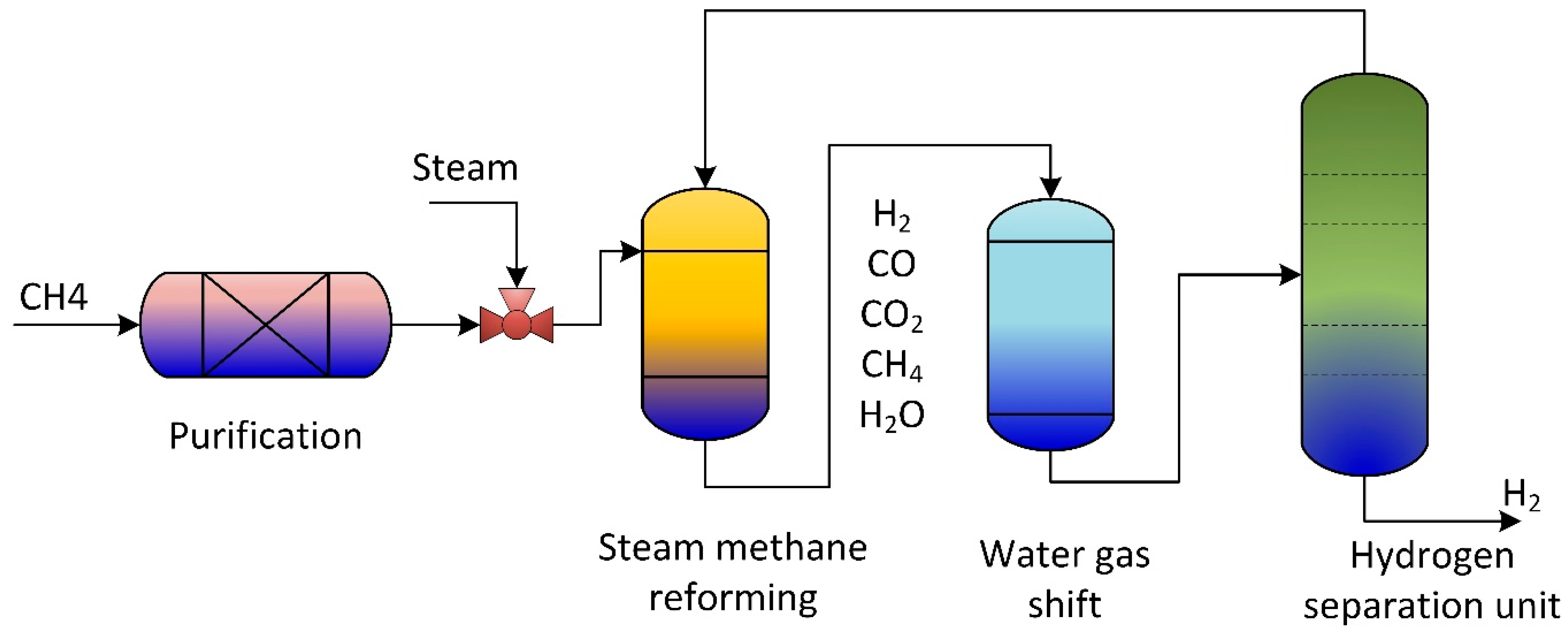

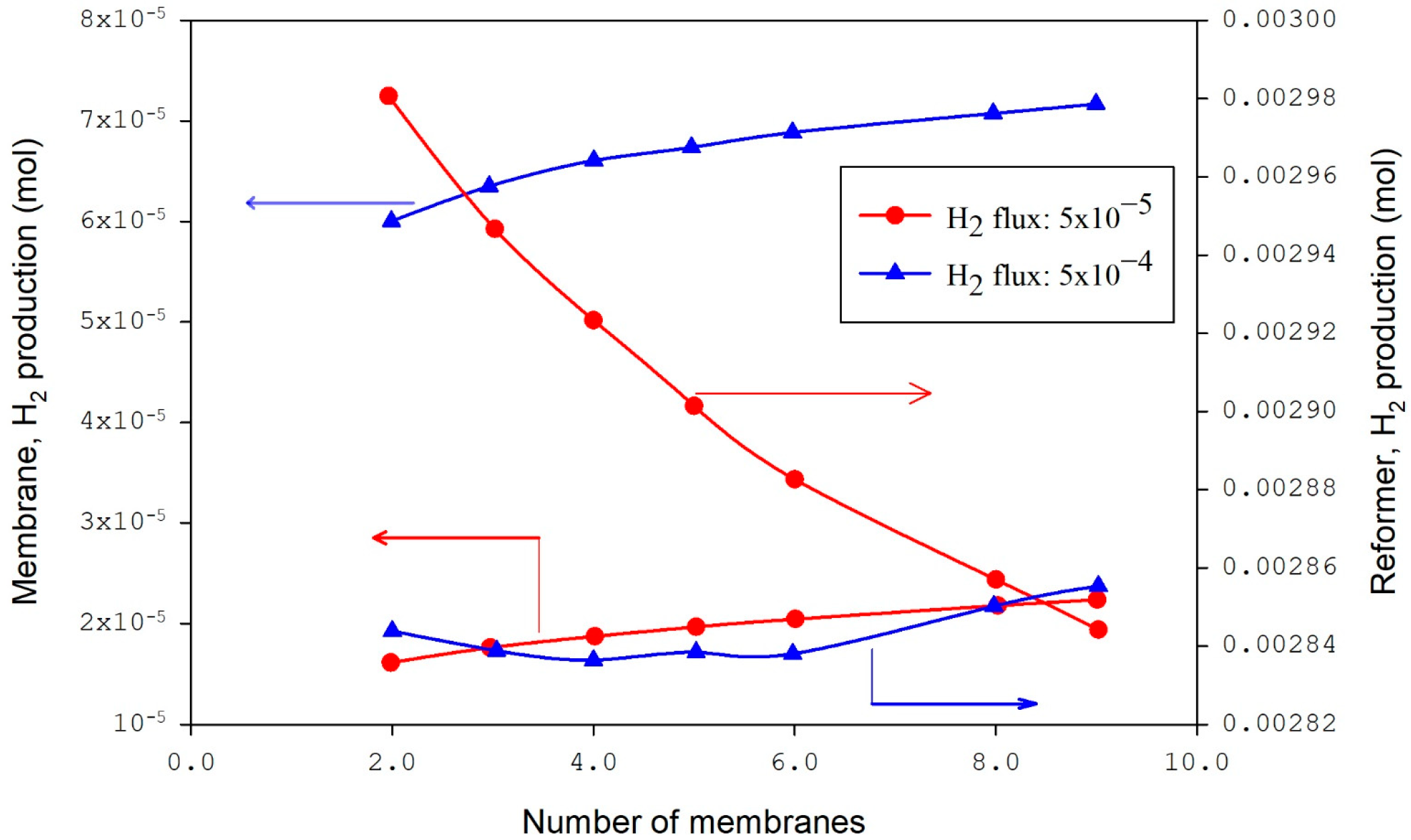
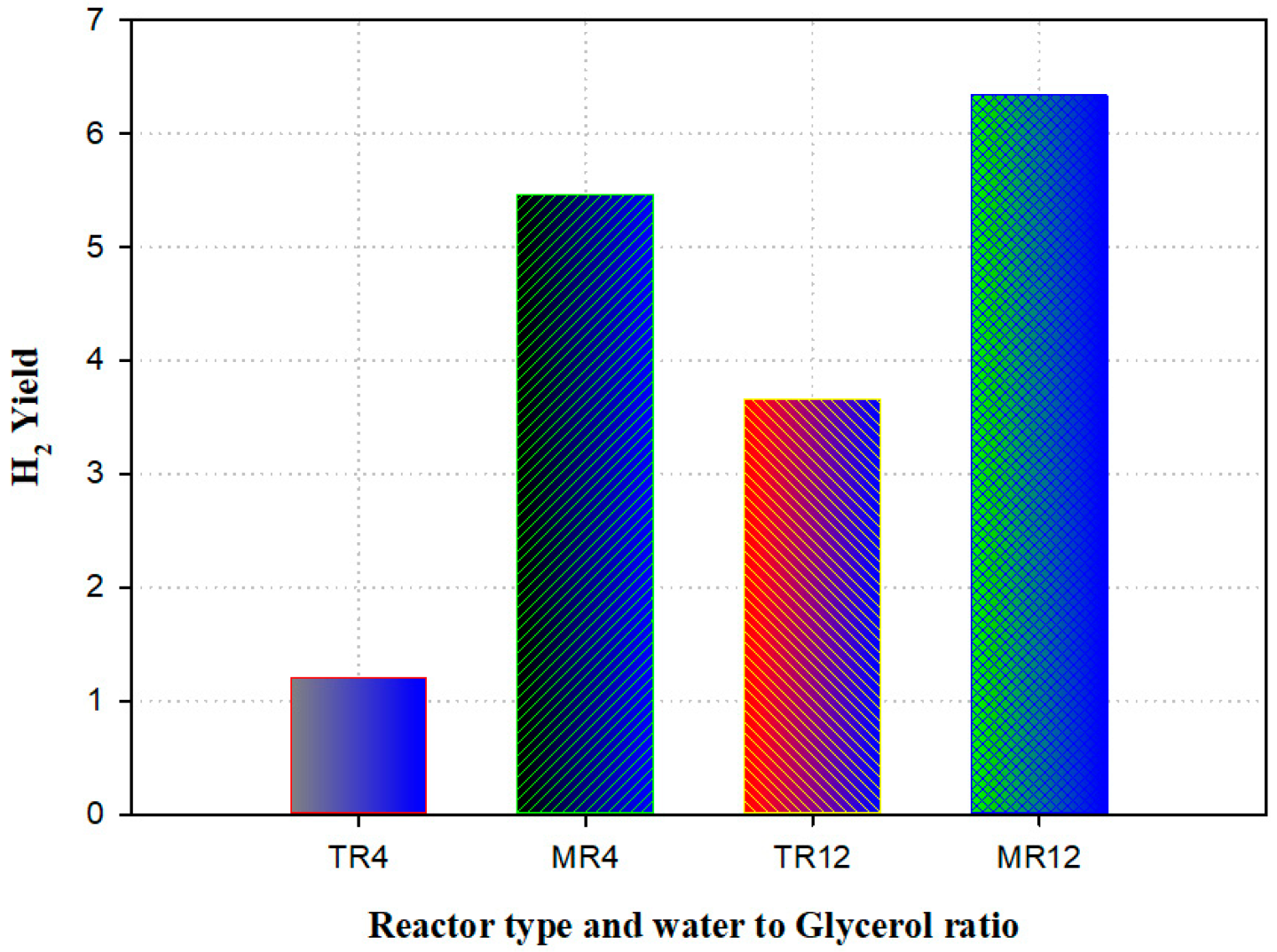
| Type of System | Process | Software | Ref. |
|---|---|---|---|
| Baffled membrane reactor | Hydrogen production by steam methane reforming | Ansys Fluent | [12] |
| Impact of catalyst bed density | Glycol steam reforming for hydrogen production | Blender 3D | [13] |
| Compact steam methane reforming process standalone application | Compact steam methane reforming process | [14] | |
| Microchannel reformer | Steam methane reforming | Ansys Fluent | [15] |
| Catalytic membrane reactor | Methanol steam reforming | COMSOL Multiphysics® 5.6 | [16] |
| Autothermal reactor | Steam methane reforming and methane combustion | SIMPLE algorithm with Fortran programming language | [17] |
| Steam methane reactor installed in a pilot plant | Steam methane reforming | ANSYS Fluent 19.0 | [18] |
| Fuel cell application | Hydrogen production from PEM fuel cell | [19] | |
| membrane-integrated reformer reactor (MRR) | Methane reforming and hydrogen separation | ANSYS Fluent | [20] |
| Radiation section of the top industrial steam methane reforming reactor | Steam methane reforming | Single program multiple data passing model | [21] |
| Wire mesh honeycomb catalytic module | Diesel reforming for hydrogen production | COMSOL Multiphysics 5.5 | [22] |
| Hydrogen generation for an on-site hydrogen refueling station (HRS) | Steam methane reforming | Ansys Fluent | [23] |
| Membrane reactor | Methane steam reforming | User-defined function (UDF) | [24] |
| Heat flow inside a catalyst particle of catalytic reactor | Steam methane reforming | Ansys Fluent | [25] |
| Hydrogen permeable membrane reactor | CO2 reforming of CH4 | COMSOL Multiphysics modeling software v5.2 | [26] |
| Catalytic wall reactors (Rh–Pd/CeO2 catalyst) | Ethanol steam reforming | COMSOL Multiphysics 5.4 | [27] |
| Catalytic reactor (Cu–Zn/γ-Al2O3 catalyst) | Dimethyl ether steam reforming | COMSOL 5.2 software | [28] |
| Fixed bed reactor (effect of radiation) | Steam methane reforming | STAR-CCM+ from Siemens PLM | [29] |
| Preheated Ni-based catalyst bed reactor | Steam methane reforming | Ansys Fluent | [30] |
| Pd–Ag membrane rector | Glycerol steam reforming process | COMSOL software | [31] |
| Catalytic bed reactor and ethanol burner | Ethanol steam reforming system | COMSOL Multiphysics | [32] |
| Fluidized bed reactor | Sorption-enhanced crude glycerol steam reforming process | Platform of MFIX CFD code | [33] |
| Catalytic membrane reactor | Ethanol steam reforming process | Comsol Multiphysics | [34] |
| Sorption-enhanced palladium membrane reactor | Methane steam reforming | Ansys commercial CFD code CFX | [35] |
| Wall catalytic steam reforming | Steam reforming of aviation kerosene | Fluent | [36] |
Publisher’s Note: MDPI stays neutral with regard to jurisdictional claims in published maps and institutional affiliations. |
© 2022 by the author. Licensee MDPI, Basel, Switzerland. This article is an open access article distributed under the terms and conditions of the Creative Commons Attribution (CC BY) license (https://creativecommons.org/licenses/by/4.0/).
Share and Cite
Ghasem, N. A Review of the CFD Modeling of Hydrogen Production in Catalytic Steam Reforming Reactors. Int. J. Mol. Sci. 2022, 23, 16064. https://doi.org/10.3390/ijms232416064
Ghasem N. A Review of the CFD Modeling of Hydrogen Production in Catalytic Steam Reforming Reactors. International Journal of Molecular Sciences. 2022; 23(24):16064. https://doi.org/10.3390/ijms232416064
Chicago/Turabian StyleGhasem, Nayef. 2022. "A Review of the CFD Modeling of Hydrogen Production in Catalytic Steam Reforming Reactors" International Journal of Molecular Sciences 23, no. 24: 16064. https://doi.org/10.3390/ijms232416064
APA StyleGhasem, N. (2022). A Review of the CFD Modeling of Hydrogen Production in Catalytic Steam Reforming Reactors. International Journal of Molecular Sciences, 23(24), 16064. https://doi.org/10.3390/ijms232416064






